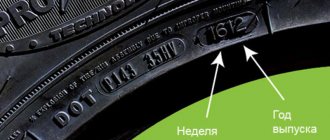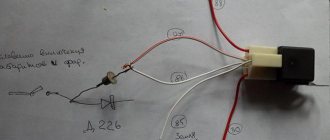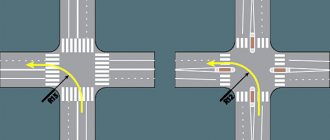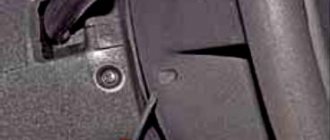A traffic island is a relatively new phenomenon on Russian roads, about which there are many contradictions in traffic regulations, and many motorists do not understand the rules for driving through these sections well and do not always understand why they receive fines. Let's try to briefly understand the rules for using this element of road safety.
Is it allowed to park (stand) on this section of the road, according to traffic regulations?
The traffic rules contain an exclusive list of road sections on which stopping and, accordingly, parking are strictly prohibited. There is no island of safety among them.
But it is worth remembering that these markings are applied to the zebra crossing, intended for pedestrians to cross the road, as well as to separate traffic flows. In the first case, they are intended for use in situations where a pedestrian does not have time to cross the road when the green light is on.
The photo shows the markings:
on zebra crossing 1.14.1
when dividing traffic flow 1.16.1
By stopping or leaving the car on this section of the road, the motorist will violate the traffic rules, where stopping and parking of vehicles at pedestrian crossings is not allowed (Read more about the fine for parking at a pedestrian crossing here).
Also, such islands are provided to separate traffic flows. If you refer to clause 12.4 of the traffic rules, you can read that it is prohibited to stop the vehicle in the area where roadways intersect , as well as closer than five meters from the edge of the intersection. In cases where there is a traffic island in these areas, stopping on it will be equivalent to this violation.
In cases where the markings are located outside the intersection, the prohibition on stopping and parking also remains. And here it is worth turning to the Rules of the Road, namely, paragraph 12.1, which allows the above actions on the right side of the road on the side of the road, and in its absence, at the edge of the roadway.
In populated areas, stopping and parking on the left side is allowed in single-lane traffic. But nowhere in the rules does it say that you can park a vehicle between oncoming lanes.
Another feature is that safety islands and guide islands, when applied to the roadway, are outlined with continuous horizontal markings 1.1, in accordance with GOST 52766-2007. And the traffic rules clearly state that crossing such markings is prohibited.
The photo shows markup 1.1:
Vehicles must be stopped only in places where stopping is permitted. To brush up on your knowledge of traffic rules, we recommend that you look at our materials about what other consequences may be for violating parking rules for stopping a vehicle:
- at the bus stop;
- by a pond;
- under signs prohibiting stopping, parking and parking;
- On Pavement;
- before the railway crossing;
- in the yards;
- on site for disabled people.
Basic provisions
First of all, in order to understand the very definition of “safety island”, you need to refer to the set of traffic rules. According to the generally accepted term, it is a specially equipped area on the road designed to separate oncoming traffic lanes or separate lanes for cyclists.
Special attention should be paid to horizontal markings (1.16.1, 1.16.2, 1.16.3.), which are applied to the road surface. They can be arranged:
- at unregulated and regular crossings;
- at an intersection where there is a roundabout;
- when entering populated areas (where there are frequent traffic jams).
The separation of the island can be in the form of a zone lined with curb stones above the roadway, road markings, or a separate section of dividing strip between traffic flows.
Nowadays there are many technical means to implement the assigned tasks. In practice, any material is used that is useful for stopping pedestrians while crossing the roadway at an equipped crossing.
What does it look like on the road and what is it intended for?
Any issues directly related to the design of safety islands are strictly regulated in legislative acts. For example, the most comprehensive interpretation of this concept can be studied in the Traffic Regulations, in the “Definitions” section - paragraph 2.42. It is there that all possible marking options are described in detail.
In fact, each island is a geometric figure, the sides of which are a solid line. Marking comes in several types and has different purposes:
- Serves for branching traffic flows (1.16.1).
- Helps merge routes with active traffic (1.16.2).
- Indicates islands where roads meet (1.16.3).
The classic traffic island is marked by road markings in an area free from vehicle traffic and is needed specifically for pedestrians. Thanks to this system, they have the opportunity to stop while crossing the roadway, if necessary, in a safe zone, rather than running across the road in front of oncoming traffic.
What fine and/or other sanctions are provided?
There is no direct prohibition on performing the maneuver in the traffic rules. A traffic police inspector can issue a fine based on the fact that the driver violated the marking requirements (you can find out how long the fine for parking in the wrong place is to pay and whether there is a statute of limitations here).
The standards indicate that elements directing movement (islands) are indicated by a solid line and inclined ones. Line 1.1 serves to mark the boundaries of roadways that prohibit driving through them.
- If marking rules are violated, i.e. crossing the lines delineating the traffic island, the motorist will be fined under Part 1 of Article 12.16 of the Administrative Code - he is charged with incorrectly observing the traffic rules prescribed by road markings. A fine can be issued in the amount of 500 rubles.
- Violating the rules provided for by traffic rules for stopping and parking, under Part 1 of Art. 12.19 of the Administrative Code, a motorist risks receiving a fine of 500 rubles, which can be replaced with a warning.
- Another option could be a sanction of 1,500 rubles, according to Part 3.2 of Art. 12.19 of the Administrative Code, for violation of parking and stopping further than the right lane from the edge of the roadway.
- And if the island was located near a pedestrian crossing, then you will have to pay 1000 rubles, this is regulated by Part 3 of the same article.
What is a traffic island?
In the traffic rules, there is a clear description of the traffic island, which implies a section of a controlled pedestrian crossing, intended for those cases when the pedestrian did not manage to cross the road lane before the traffic light switched. This space is marked with marking 1.1 (or 1.2.1), crossing of which is strictly prohibited, not to mention the prohibition of entry into the pedestrian zone.
Also, guide islands, which separate traffic flows and are essentially part of an intersection, are often confused with traffic islands. This section is also separated by markings 1.1 or 1.2.1 (solid line), and crossing the solid line is prohibited.
Controversial situations and ways to avoid punishment in such cases
Controversial issues also exist in such cases. You were given a fine for violating the markings, but the stop was forced. There are two situations worth considering here:
- The traffic police inspector issues a fine - if the car is really faulty, then you can explain the situation to the traffic police officer on the spot and thereby avoid a monetary penalty.
- The violation was recorded on camera - here the judge will have to prove his case. The camera only takes photos, so it is not clear whether you stopped due to a technical fault or are simply violating traffic rules. In this situation, you can try to explain in court that you did not plan to park, and the stop occurred out of necessity.
It is also necessary to check the articles specified in the protocol; if you were given a fine under an article that does not correspond to your violation, then such a decision can be challenged.
Penalty for entering a traffic island
Unfortunately, the traffic rules and the Code of Administrative Offenses do not have a clear clause that would describe penalties for entering or stopping at a traffic island. Despite this, a traffic inspector may issue a fine, depending on the specific stop location:
Regardless of the traffic situation, since the islands are indicated by a solid line, their intersection falls under Art. 12.16 Code of Administrative Offenses of the Russian Federation “On non-compliance with the requirements prescribed by road signs or road markings”, paragraph 4, namely:
If the car owner made a stop in a pedestrian zone or at the intersection of traffic flows of the same level. These actions fall under Art. 12.4 Traffic Regulations of the Russian Federation “Stopping is prohibited”, where one of the paragraphs reads:
In the first situation, the driver can get off with a verbal warning or a fine of up to 500 rubles, in the second - up to 2,000 rubles.
Since neither the Traffic Regulations nor the Code of Administrative Offenses have a clear concept and restrictions regarding safety islands, representatives of the traffic police are guided by related points and rules, and this implies some freedom of action within the framework of current legislation. All situations are controversial, and the final amount of the fine will depend, first of all, on your actions and the conscientiousness of the traffic inspector, so if you do not want to get a fine for stopping on a traffic island, spend a few extra minutes and stop the car in the right place.
How can the traffic police prove your guilt?
When drawing up a report on an offense, the traffic police officer must provide compelling evidence of what happened. As a rule, materials on the violation made using video or photography are attached to the case.
The capabilities of modern technical devices make it possible to create an evidence base that illuminates the picture of the event with extreme clarity. If possible, the traffic police officer will certainly try to stock up on witness statements. To do this, directly at the place where the protocol was drawn up, eyewitnesses of the violation are asked to give testimony.
In large cities, violations of marking rules (crossing a traffic island) are recorded using automatic video cameras installed throughout the city. And in this case, the driver will receive the decision by mail in the form of a “chain letter”.
Is it possible to stop at a “safety island”?
In big cities, you can find “safety islands” on the roads intended for pedestrians. They are needed so that a person has time to wait if he does not have time to cross the road when the traffic light signal permits. However, drivers also enter this zone, for which they will face a fine or other penalties, which is worth talking about in more detail.
Why do they stand on “islands of safety?” Motorists usually stop at “safety islands” to look at the route on a map or to take a break on a long trip. However, there are also cases when owners simply leave their vehicles and leave. Other reasons for stopping in these areas include:
- There is no parking space in the center
- You need to make an urgent phone call
- The car broke down
- Waiting for one of the passengers
Penalty for stopping and parking in a restricted area. It is worth immediately noting that under almost any circumstances, stopping at traffic islands will lead to payment of a fine or towing of the car. You can find zones for pedestrians in places where passing traffic flows separate, at intersections and near zebra crossings.
In case of violation of the law, the motorist will suffer the following punishment:
- When a vehicle stops in a pedestrian crossing area, it can block the view of both the driver and the pedestrian. According to Article 12.19 of the Code of Administrative Offenses of the Russian Federation, the fine will be 1000 rubles
- If an area is marked with yellow lines, parking there is prohibited and the vehicle will be towed
- If a “safety island” is drawn before a road intersection, the motorist has crossed a solid marking line, the fine will reach 500 rubles
- If there is no sign 3.27 in the “safety island” area, the motorist will not be fined; you can stand in the pedestrian zone, but not for long, the driver cannot move away
- If the “island” is located in an area where traffic flows in the same direction diverge, the driver may be fined 500 rubles if the circumstances are recorded by a road surveillance camera
Bottom line. In big cities there are “safety islands” designed for pedestrians who did not cross the road in time. However, drivers ignore the rules and leave their cars in this area.
As a result, such actions will lead to a fine or towing of the vehicle, depending on the circumstances. However, it should be remembered that stopping and parking in protected areas is prohibited and it is better to avoid them to avoid problems.
Penalty for crossing a traffic island
- Penalty for crossing a traffic island
- What is a traffic island and what does it look like?
- What is the island used for?
- Penalty for entering and crossing a traffic island
Road markings are as important as road signs, so all road users on public roads must take all their requirements into account. Violation of traffic regulations entails the imposition of penalties on drivers, in particular for crossing or parking cars on traffic islands. What kind of places these are, how they are marked on the road and what kind of punishment the servants of the law usually use - this will be discussed further.
Traffic on tram tracks
One of the most common traffic violations is avoiding traffic jams along tram tracks. As we know, tram tracks are not roadways. Nevertheless, drivers receive a fine under Part 1 of Article 12.15 of the Code of Administrative Offenses of the Russian Federation for violating the rules of location on the roadway.
12.15.1. Violation of the rules for placing a vehicle on the roadway, oncoming traffic, as well as driving along the side of the road or crossing an organized transport or pedestrian convoy or taking a place in it
How is it possible that traffic is outside the roadway, but the fine is for being located on the roadway? It's simple, traffic on tram tracks is regulated by the rules of location on the roadway. A location outside the roadway that does not comply with the rules is a violation.
9.6. It is permitted to travel on tram tracks in the same direction, located on the left at the same level as the roadway, when all lanes in this direction are occupied, as well as when detouring, turning left and making a U-turn, taking into account clause 8.5 of the Rules.
This is the only condition for movement on tram tracks in accordance with the requirements of the Rules.
What is a traffic island and what does it look like?
Options for marking “road islands” are given in the Russian Traffic Regulations in paragraphs 1.16.1–1.16.3, but they all indicate a place on the roadway necessary for better traffic control and prevention of emergency situations in difficult areas. Such markings may be located on the road itself or next to the dividing strip, but in any case the GOST requirements for dimensional values must be observed.
For example, from the edge of the road to the line of the island there should be 7.5 m, and the width of the selected section cannot be narrower than the pedestrian crossing if its length is at least 1.5 m. (to paraphrase, it’s not clear) It’s easy to miss the sign of an island on the road impossible, since all the applied thick white stripes (both horizontal and vertical or contours) stand out strongly against the background of the dark canvas, and the width of such a section will not allow it to go unnoticed. The edges of the islands are always marked with a single solid line, crossing which in accordance with the traffic rules of the Russian Federation is prohibited.
Design features of the carburetor
So, the simplest option, which almost always helps, is to adjust the carburetor, when there is no need to disassemble and remove the device. However, before proceeding directly to the process, you should study the device in order to independently understand how to adjust the carburetor.
- Jet holder for idle shot.
- Throttle valve locking screw.
- Idle mixture adjustment screw.
- Idle speed adjustment screw.
In reality, of course, the structure of the device is much more complicated, but to adjust the idle speed with your own hands, this knowledge is quite enough, of course, if you have minimal plumbing skills.
Crinkle zones
Of particular importance is the place where the device is attached. It must withstand heavy loads from a 3-ton trailer, and on the other hand, be safe in case of a rear impact during an accident.
The fact is that manufacturers calculate the car to withstand the loads of an accident without a tow bar. If you look at the design of the metal body, you can note three main zones. The interior is protected by a rigid capsule designed to maintain geometry in the event of an accident. But in front and behind there are so-called crushable sectors, which are designed to absorb the energy of impacts. Videos of crash tests show how a crashing car first crushes the front end into an accordion and then bounces off, keeping the interior cocoon intact. The body behaves in the same way in rear collisions.
But with the help of a tow bar, the body structure changes. The towbar is a load concentrator. Therefore, it is very difficult to find truly secure attachment points in the side members so that they can withstand the loads of the trailer and would fold correctly in the event of an impact.
Is it possible to stop by
As you understand from what was written above, that in the text of the traffic rules, the phrase “safety island” does not appear, then there is no point in looking for an answer to the questions: is it possible to drive in or is it possible to park there?
Here you just need to pay attention to how the boundaries of these elements are marked? That's right, a solid marking line that cannot be crossed. True, there is one exception, but it has nothing to do with our question. By the way, I have written a separate article about solid lines, which describes all their types, purposes and possibilities of their intersection.
It turns out that we cannot cross a solid line, except if it marks the right edge of the roadway for the purpose of stopping on the side of the road, and therefore driving into a traffic island even more so.
Where can large families park for free?
What is a traffic island on the road? Is it possible to drive in and park on the markings?
Only in paid parking zones in Moscow and St. Petersburg, subject to residence in these cities, respectively. Or at places allowed for stopping according to traffic regulations.
In paid parking lots, large families can stop for free if all the following conditions are met simultaneously:
- there are at least 3 children in the family,
- all children are minors,
- A permit has been obtained for this vehicle.
Thus, you cannot just come and park your car in a paid parking zone, being a parent with many children. To do this, in 2022 you must first obtain a special permit. It is issued at the MFC if there are documents about having many children.
Stopping (parking) on traffic islands, guide islands
Hello, dear readers! This article will discuss violations of traffic rules when stopping (parking) on traffic islands, guide islands, which drivers often use for purposes other than their intended purpose.
Let's turn to GOST R 52766-2007 to understand the definitions of “Guiding islands” and “Safety islands”.
GOST R 52766-2007 Public automobile roads. Arrangement elements. General requirements.
4.2.4 Guide islands
4.2.4.1 Guide islands are designed to separate traffic flows in directions at intersections of highways when the total traffic intensity on intersecting or adjacent roads is at least 1000 vehicles/day, when the number of turning vehicles is at least 10% of the total traffic flow on roads outside populated areas and not less than 20% in populated areas.











